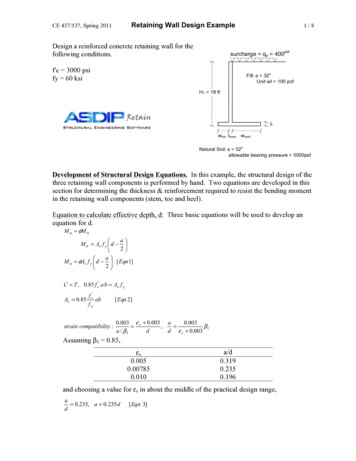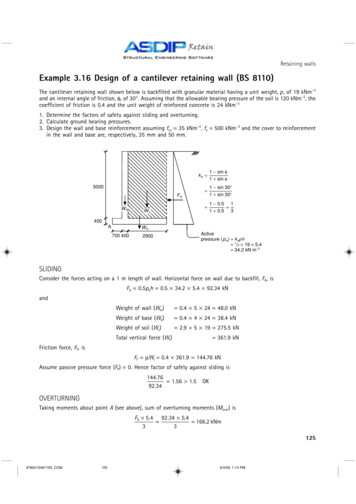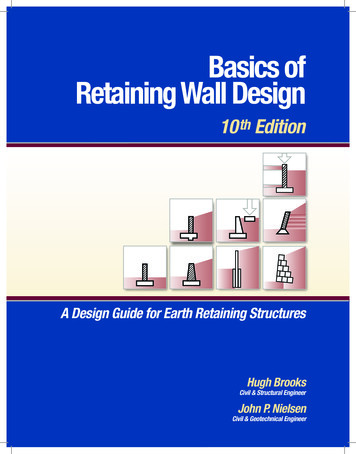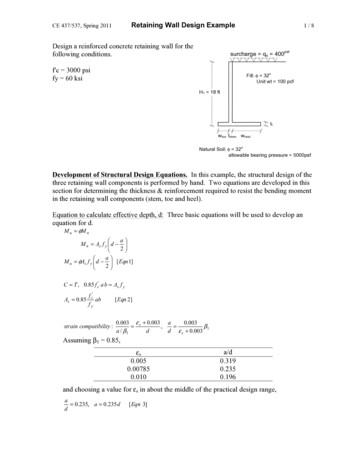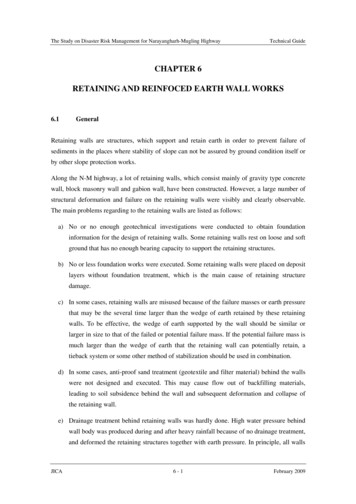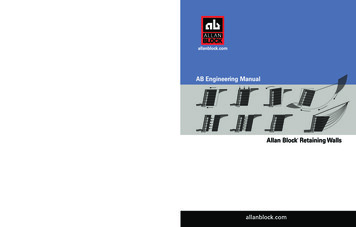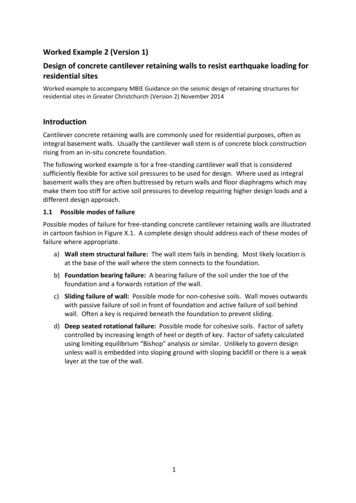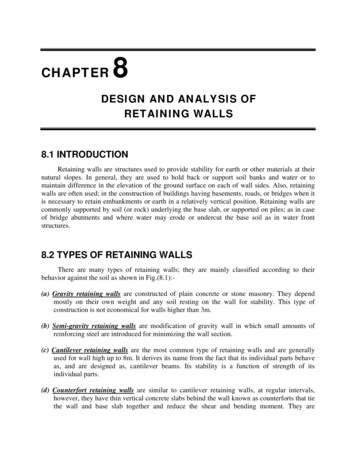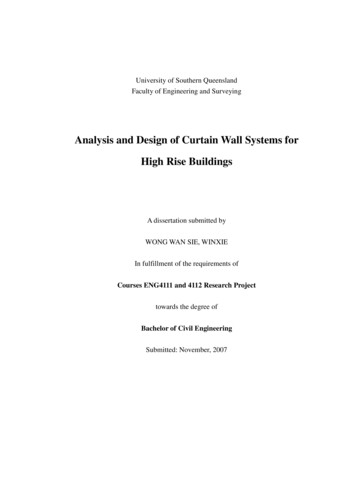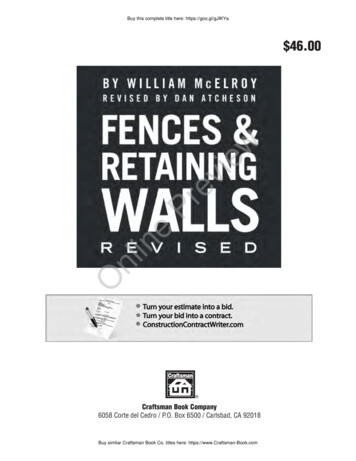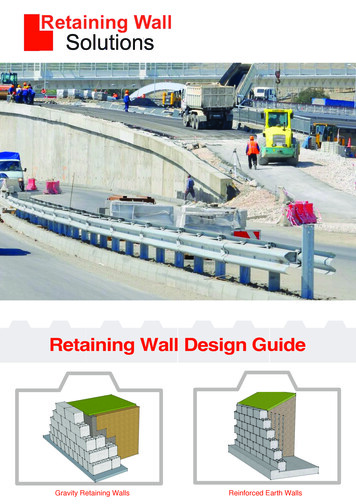
Transcription
Retaining Wall Design GuideGravity Retaining WallsReinforced Earth Walls
Basic Design PrinciplesThis is a simple explanation of the principles of retaining wall design.The diagrams below show the core functions and the design criteria for a retaining wall. The following failure criteria areencountered while designing a retaining wall.TMInterlock Wall SolutionsTMInterlock Wall SolutionsTMInterlock Wall SolutionsTMInterlock Wall SolutionsTMInterlock Wall SolutionsOverturningBearing capacitySlidingSlope stabilityShearOverturning - The material being retained creates a force (moment) that causes toppling of the wall. The weight of agravity retaining wall resists this moment.Bearing capacity - The weight of the wall and earth is supported by the base. The ground bearing capacity needs to bechecked to ensure any settlement is within limits.Sliding - The material being retained creates a horizontal force that can cause the retaining wall to slide. This is resistedby the friction between the wall and earth beneath and the embedment of the wall.Stability - The earth around the wall requires adequate strength to avoid an overall slip failure.Shear - The blocks can shear at the base or between courses. We introduce a kicker at the base and interlocking buttonsto resist these forces.
Design TablesThere are a number of solutions to overcome the failure modes discussed on the previous page. Oursolutions are based on interlocking concrete blocks. We have designs for four types of retaining walls.They are:TMInterlock Wall SolutionsTMInterlock Wall SolutionsTMInterlock Wall SolutionsTMInterlock Wall SolutionsGravity retaining wallsReinforced block retaining wallsInclined retaining wallsReinforced earth retaining wallsThe following pages include details on each type of wall and include a design table. The design tablesinclude a number of varibles.Glossary of TermsHeight of Wall - The effective height of the retaining wall.Block Type - Blocks come in either 300mm, 600mm, and 800mm widths. Refer to data sheetsfurther below within this document.Base Width - The design width of the foundation base.Base Depth - The design depth of the foundation base.Rebar Toe - The bar diameter and spacing of the base toe reinforcement.Rebar Heel - The bar diameter and spacing of the base heel reinforcement.Pocket Rebar - The vertical bar diameter and number of bars within each pocket.Wall Incline - The angle of the inclined wall. We can design for various wall inclines that may resultin different block requirements.Surcharge - The vertical load expressed as a uniformly distributed area load at the top of the wall.This is shown as a car park in one of the examples.Factor of Safety - This is based upon a mobilisation factor of 1.5Cost Index - This number represents 100m of constructed wall but does not include earth works.The number 80 80,000 to build 100 linear meters of wall.www.retainingwallsolutions.co.uk
Gravity Retaining WallsGravity retaining walls are a basic design and rely on the mass of the wall to retain the earth behind.A very simple method to design a gravity retaining wall is to use the base width x 2 to calculate the height.The wall in figure 1 is 800mm wide and 1600mm high. As a rule of thumb this method works and will give a factor ofsafety in excess of 1.5 in most cases.As a general rule you can build economical gravityretaining walls from 600mm high to 4m high.The foundation does not need to be reinforced, howeverproviding a kicker at the front edge will restrain the wallfrom slippage.In poor soils the foundation can be constructed deeperand wider to add more resistance. Inclusion of drainagematerial to the back of the wall together with drainageholes at the bottom of the wall is recommended torelieve hydrostatic pressure.Figure 1Figure 2 on the left is an example of a 4m high gravityretaining wall using 800mm wide blocks.The wall has been designed to the characteristics in thetable on the next page.The blocks interconnect to stop course slippage. The topcourse can be flat or sloping depending on the customersrequirements.The concrete strength is a minimum 25 N/mm2. .Othermixes are available for more aggressive environments.Figure 2
Gravity Wall Design TableDesign Table 1The design table above presents Indicative designs based upon a base material with allowable bearingpressure of 200kPa.The retained material is assumed to be well graded, granular backfill with back of wall drainage or weep holesto relieve hydrostatic pressure.All indicative information presented in this table is based upon assumed loading and ground conditions andmay be subject to change following detailed, site specific design.Ideal For River Bank Errosionwww.retainingwallsolutions.co.uk
Reinforced Block Retaining WallsThe reinforced block wall is the more economical solution for taller walls than gravity walls. The design is based oncasting full depth rebar voids through the blocks.Rebar cast into the foundation is lapped onto rebar located within the vertical voids.The wall rebar is then placed into the wall and fixed using a cement based grout.The example wall shown in figure 3 is5.6m high using 800mm blocks.The design characteristics are shown onthe table on the next page.The foundation together with the wallacts as a cantilever to retain the materialbehind the wall.Placing drainage material to the back ofthe wall together with drainage holes atthe bottom of the wall is recommended torelieve hydrostatic pressure.The reinforced wall has improvedretaining design characteristics whichallows for higher surcharge loads to beresisted.Figure 3The block in the example in figure 3 is ourStackablock as shown here in figure 4.As you can see in the table we use our 600mmVitablock for smaller walls.All blocks come with a lifting bolt and a lifting clutch.The blocks are manufactured to BS 8500 standardwith a compressive strength of 25 N/mm2. We cancast blocks in other design mixes for more aggressiveenvironments.Figure 4Patent Pending - We have filed for a patent andregistered the design for this product.
Reinforced Wall Design TableDesign Table 2The design table above presents Indicative designs based upon a base material with allowable bearingpressure of 200kPa.The retained material is assumed to be well graded, granular backfill with back of wall drainage or weep holesto relieve hydrostatic pressure.All indicative information presented in this table is based upon assumed loading and ground conditions andmay be subject to change following detailed, site specific design.Ideal For a Failed Retaining Wallwww.retainingwallsolutions.co.uk
Inclined Block Retaining WallsAn inclined block retaining wall is the most economical solution as it uses the inclined blocks and gravity to add resistanceto the forces trying to push the wall over. The design concept is similar to gabion wall construction but results in a plainconcrete face to the wall and is ideal for situations where gabion baskets are likely to corrode within a short time period.For example, in the cost index within the design table it can be noted that a 4m inclined block wall is 100 compared to 125for a similar gravity block retaining wall. The reinforced wall is a similar cost but when earth works are then considered,the inclined wall will be more economical.Building an Inclined Block RetainingWallTo construct the wall a taperedfoundation at the inclined angle is cast.The foundation requires a single layer ofreinforcement as indicated in the designtable.Single courses of blocks are laid and theretained material is then placed tosupport the block and compacted.We can provide full installation methodand risk assessments on request.The kicker stops the block from slippingduring compaction.The interlocking buttons then stop slip asthe wall is constructed and compacted ateach cource.The top layer of blocks can be suppliedwith a flat or sloping top as required.Figure 5Technical drawing of all our blocks areavailable from the website.Figure 6
Design TableDesign Table 3The design table above presents Indicative designs based upon a base material with allowable bearingpressure of 200kPa.The retained material is assumed to be well graded, granular backfill with back of wall drainage or weep holesto relieve hydrostatic pressure.All indicative information presented in this table is based upon assumed loading and ground conditions andmay be subject to change following detailed, site specific design.Ideal For Earth Workswww.retainingwallsolutions.co.uk
Reinforced Earth WallsRetaining walls higher than 4.2m become more expensive using the gravity retaining wall solution. Our next solution is areinforced earth wall.In figure 1 below, the block of earth directly behind the wall is the reinforced earth wall. This is constructed by laying earthfill in layers with a geo mat between each layer. The reinforced earth wall then becomes the structural element that willretain the earth behind it.The Virtabloc acts as the facing to the wall and protects it from the elements and erosion.A kicker is created at the toe of the foundationto give greater resistance to slip.Figure 7This is a very economical solution for highwalls.Wall height can be as high as 12mFigure 8The geo mat is fixed to the Virtabloc usinggalvanised steel hooks that are cast in.A galvainsed steel rod is then threaded behindthe geo mat and through the hooks restrainingthe geo mat in place.Geo MatGeo mat is a layer of plastic that has a tensile strength between 50 and 170 Kn/m depending on the grade required forthe project.
Geo MatWe use E'Grid uniaxial geogrid with our Virtabloc to design and build reinforced earth walls. E'Grid is laid and fill materialplaced on top. This is then consolidated and a second layer placed over it. This process is repeated until the wall isfinished.We build our reinforced earth walls in 300 mm fill layers as this fits in well with the dimensions of our blocks at 600mm.E'Grid reinforcement improves the bearing capacity and safety of the structure making savings on construction cost.We selected E'Grid as our preferable geo mat due to its strength and competitive pricing for customers.The design life of E'Grid and our Virtabloc facing is 120 years.The table below show the various strength of each type of E'Grid. The selection depends on the design of the wall.www.retainingwallsolutions.co.uk
StackablocStackabloc is used to build gravityretaining wallsStackabloc measure 800mm wide x 800mm high and are1600mm and 800mm long.They offer greater mass than ourVirtabloc version that have a cross section of 600mm x 600mmStackabloc are very versatile and can be used for multiplepurposes, such as:TMBuildingsInterlock Wall SolutionsTMInterlock Wall SolutionsTMInterlock Wall SolutionsTMInterlock Wall SolutionsTMInterlock Wall SolutionsBund wallsRetaining wallsSafe walking waysSecurity blocks
Stackabloc RStackabloc R is used to buildreinforced block wallsStackabloc R has the same dimensions as Stackabloc. Theonly difference is the introduction of two 100mm dia ducts inbetween the interlocking buttons closer to the rear of the blockto give the greatest advantage for the rebar reinforcement.This allows us to use the blocks in reinforced retaining walls.The height of the wall determines the size of reinforcement andthe cantilever foundation. Refer to the design table for moreinformationA very simple solution that allows very high retaining walls to beconstructed extremely competitive prices.Call 0800 880build solution.3135 today for a comprehensive design andwww.retainingwallsolutions.co.uk
VirtablocVirtabloc is used to build gravityretaining wallsVirtabloc measure 600mm wide x 600mm high and are1800mm, 1200mm, 900mm and 600mm long. They are usedfor smaller and slightly more economical gravity retaining walls.For greater mass we recomend the use of Stackabloc.Virtabloc & Stackabloc are very versatile and can be used formany other purposes, such as:TMInterlock Wall SolutionsTMInterlock Wall SolutionsTMInterlock Wall SolutionsTMInterlock Wall SolutionsTMInterlock Wall SolutionsBuildingsBund wallsRetaining wallsSafe walking waysSecurity blocks
Virtabloc RVirtabloc R is used to buildreinforced block wallsVirtabloc R has the same dimensions as Virtabloc. The onlydifference is the introduction of two 100mm dia ducts inbetween the interlocking buttons closer to the rear of the blockfor the rebar reinforcement.This allows us to use the blocks in reinforced retaining walls.The height of the wall determines the size of reinforcement andthe cantilever foundation. Refer to the design table for moreinformationA very simple solution that allows very high retaining walls tobe constructed at extremely competitive prices.Call 0800 880build solution.3135 today for a comprehensive design andwww.retainingwallsolutions.co.uk
Earth BlockEARTHBLOC is used to buildreinforced earth wallsEarthblocs measure 300mm wide x 600mm high and are1800mm and 900mm long.A pair of hoops are cast into each block to hold thehorizontal ties to the earth wall. These act as therestraint.The hooks are made from 8mm galvanised round bar.The geo mat is held in place by threading a 32mm heavyduty polypropylene pipe through the hoops. Thisrestrains the geo mat in place. This construction gives alife time span of over 75 yearsA very simple solution that allows very high retainingwalls to be constructed at very competitive prices.Call 0800 880 3135 today for a comprehensivedesign and build solution.
Design and Build ConsultingAt Blockwalls, we pride ourselves on a holisticapproach to provide clients with solutions for theirengineering problems. Our designing service allowsclients the freedom to utilise concrete blocksefficiently with great value for money. In thisbrochure, some examples of our retaining wall designhave been displayed. These are indicative and willrequire additional calculations depending upon thegeotechnical conditions.We encourage clie
The reinforced wall has improved retaining design characteristics which allows for higher surcharge loads to be resisted. Reinforced Block Retaining Walls The block in the example in figure 3 is our Stackablock as shown here in figure 4. As you can see in the table we use our 600mm Vitablock for smaller walls.
